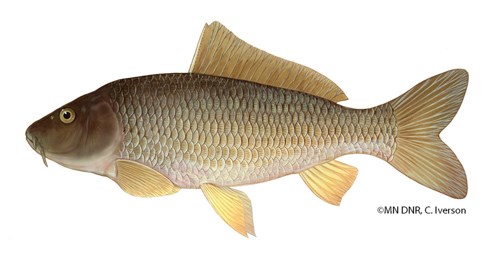
Used with permission of MN DNR and C. Iverson. IntroductionOf all the fish swimming about the Mississippi National River and Recreation Area, few can compete with the common carp for controversy. Since its introduction into North American waters just over a century ago, the anglers and diners who had once celebrated its arrival with parades have come to generally revile it, no longer praising "the queen of rivers" so much as cursing "ol' puckerpuss" and "buglemouth." The carp has so successfully assimilated itself into the nation's waters that it is likely here for good. As European and Asian anglers have for centuries, an increasing number of North Americans are perfecting doughball recipes and relishing the challenge and, they insist, fun, of fishing for these hard-fighting, powerful fish. Their commercial counterparts, meanwhile, continue to pull hundreds of tons of carp annually from area waters, including the Mississippi and St. Croix Rivers. HistoryThe Common Carp's Introduction into North AmericaArriving in the United States during the mid-1800s, increasing waves of immigrants could scarcely believe that this vast new land had no carp - it had been a cultivated food source, garden element, and symbol of strength and courage in Asia for over 4,000 years, and similarly esteemed in Europe for nearly 2,000!
Inspired by the European model (whereby the Austrian princes of Schwarzenberg maintained 20,000 acres of carp ponds), scattered entrepreneurs began to import the prized fish, hoping to provide a familiar, profitable food staple to the rapidly growing nation that was losing its native fish to overharvesting and pollution.
Julius A. Poppe was one of the most successful, expanding a stock of five common carp imported from Germany in 1872 into a thriving California farm by 1876. Fielding orders from throughout the country, he actively began to lobby for national cultivation of the hearty fish: "There ought to be one person in every county who would raise choice carp as stock fish to sell to others to fatten for their own tables. It would be a cheap but sumptuous food and at the same timevery convenient, as they are ready to be eaten at all times of the year. Faced with such public pressure to make carp more widely available and the worrisome decline of native fish stocks after a century of intense exploitation, the U.S. Commission of Fish and Fisheries began an intensive effort of carp cultivation in 1877. Subsequent efforts by state Fish Commissions had introduced the carp to many area waters by 1883, and the fish's remarkable ability to live and reproduce in most every water condition allowed it to quickly infiltrate others. A Fish once Prized, Now DespisedBy the turn of the century, the introduction of the carp was such a "success" that both public agencies and sportsmen had come to regard the fish as a nuisance. While carp were being harvested from area waters, they were comparable in taste to neither the selectively bred, clean water-cultivated carp of Europe nor, it was believed, to many of the native "game" species, and were thus useless as a food source.
Either ignorant of or blind to the damages they themselves had wrought on the landscape, people looked past the dredged and straightened channels, drained wetlands, eroded riverbanks, and waters laden with human and industrial waste, saw carp roiling in the shallows, and accused them of wrecking water quality and gamefish populations, although the loss of gamefish was primarily due to deteriorating water quality rather than through direct competition with carp.
As the carp is both a prodigious reproducer and highly tolerant of pollution, it spread quickly through waters in which many native species could no longer live.
A bottom-feeder, it roots along the floor of a body of water, frequently uprooting vegetation, and roiling the water. This increases the turbidity (muddiness) of the water, which in turn reduces the ability of predator fish (such as pike or walleye) to see their prey and other species that prefer water relatively free of sediment. Increased turbidity also reduces the amount of sunlight received by water plants, reducing their growth or eliminating them and many native species reproduce or find cover in plants. As plants disappear, so do the waterfowl which depend upon those water plants for food.
Carp can quickly crowd out other fish with sheer numbers, as well, as females lay up to 2 million eggs when spawning, and fry can grow as large as 8" in the first year. Thus, the health of numerous small lakes and fisheries has suffered from the presence of the carp. The fish's impact upon larger bodies of waters remains minimal when compared to that of human activity. Controlling CarpDue to the perceived impacts of the carp upon our waters, concentrated state efforts to permanently eliminate the fish by trapping, seining, and poisoning were frequently undertaken early in the century. Few were entirely successful, however, as the carp was simply too adept at reproducing and thriving in our polluted waters. (Having learned from the introduction of carp and other organisms, exotic species control programs presently take an aggressive preventative approach to their spread from the beginning).
Conceding to the fish's permanence, carp removal programs began in the 1950s to concentrate instead upon the control of carp populations and their migration into gamefish waters. Most State agencies, in fact, have favored State-regulated commercial fishing to removal programs since the early 1980s. |
Last updated: December 11, 2017
